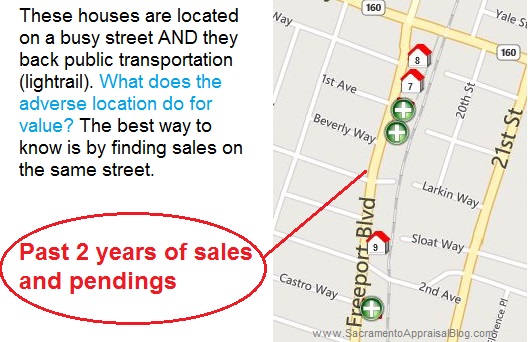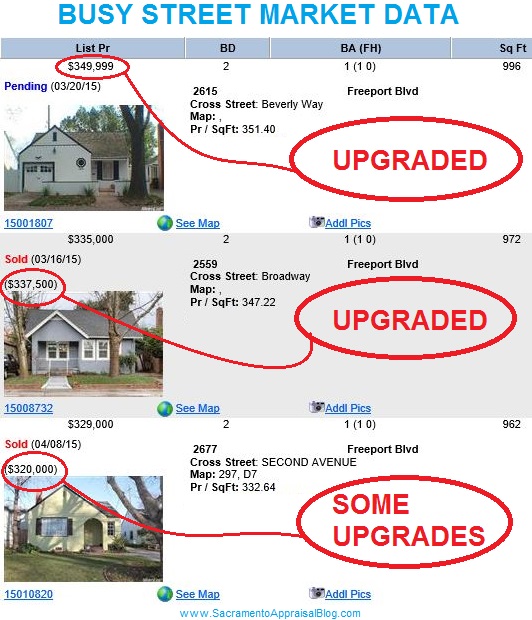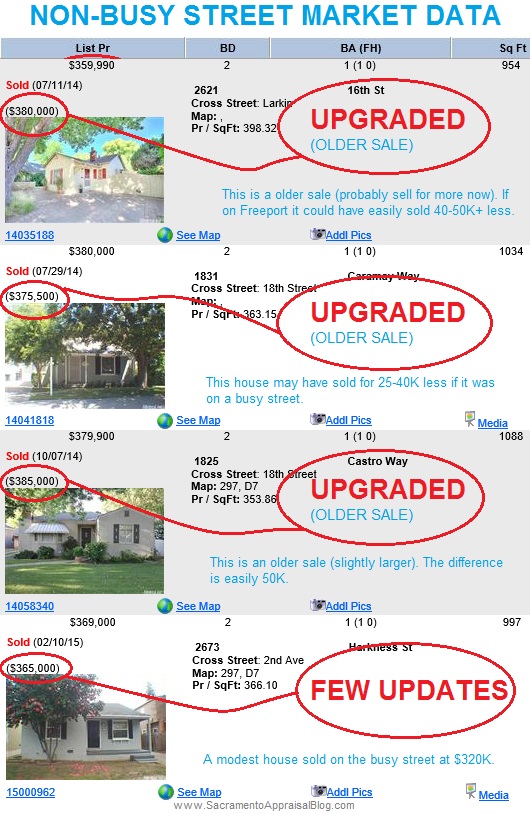We all know most buyers are going to pay less for a home on a busy street. But how much less? Is it really only something minimal like $5,000 or $10,000, or is it much more substantial? Knowing how to come up with adjustments is critical for anyone working in real estate, so let’s walk through a two-step example below to shed some light on how appraisers might approach a busy location.
The Temptation: It’s easy to use the same adjustments in every neighborhood and in every market, but there is no one-size-fits-all adjustment that will work in every case. This is why we need to know how to research the market.
Here are a couple key points and steps:
1) The best comps don’t need adjustments:

The first thing we want to do is look for sales and listings on the same street. When we have similar sales with roughly the same location, these properties tell us exactly what the market is willing to pay. There is no guessing and no need to use many other sales because we essentially have the best examples of properties that have already been vetted by the market. If we pull sales or listings from a superior street, it’s easy to minimize the adverse location. But if all the sales on the busy street are coming in substantially lower than surrounding sales, the market has spoken. If you don’t have recent sales, you can look at much older sales on the same street, and study other nearby sales at the time to see how much of a value impact there was. If there are zero sales on the subject street, find a competitive busy street in the market area (or maybe even a commercial location or something quasi-similar). There has to be something out there. Also be sure to look at actives, pendings, expired listings and withdrawn listings since they can sometimes give clues on value.
2) Comparing busy vs. not busy:

This is where we take a good look at any potential price difference between sales and listings on busy and not busy streets. We have to make sure we are comparing “apples to apples” so to speak, so pay close attention to size, condition, upgrades, lot size, layout, garage space, etc… The goal is to match up several sales instead of just one example because this helps us have a better context of support. In truth we might end up coming up with a range of value for what we think the adjustment should be too. That’s okay. Just ask yourself where your property realistically fits on the range of value spectrum.

The Verdict: There haven’t been many recent sales in the immediate area lately, which makes it a more involved process to establish value. But even with these older sales, the value difference is fairly large, right? When looking at sales on Freeport Blvd vs competitive sales on typical streets, it looks like the value range is easily anywhere from 25-50K+. If we spent more time on this, we could hone in on a tighter range, but you get the point, right?
NOTE: I am not saying this is the adjustment to give. This is simply a quick snapshot of the market right now for the sake of illustrating a methodology. Remember that these properties on Freeport Blvd also back to public transportation too.
I hope this was helpful. I’d love to hear your take in the comments below.
Questions: Any further insight or stories to share? How have you seen an adverse location impact the value of a property?
This article was originally published HERE for more articles from Ryan Lundquist you can visit sacramentoappraisalblog.com.
If you have any comments or would like to submit content of your own email comments@appraisalbuzz.com








